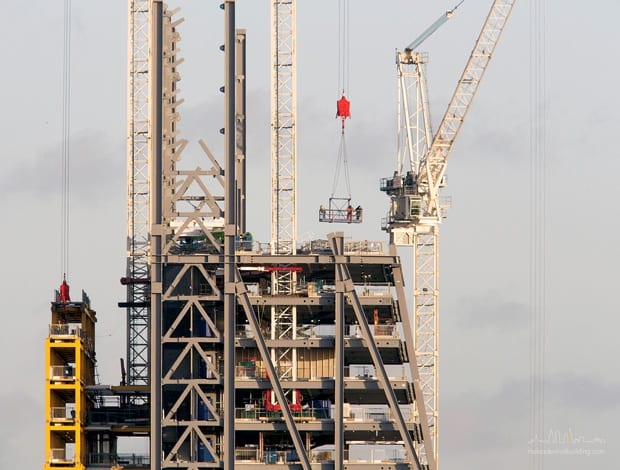 BIM – and talented personnel in all sectors – were key elements of the success of the Leadenhall Building||
BIM – and talented personnel in all sectors – were key elements of the success of the Leadenhall Building||
Design and build contracts take the risk out of a project for a developer client. they don’t always win plaudits from architects, but it doesn’t have to be that way, as the leadenhall building shows
Architects often get upset about design and build contracts. They think that giving a builder so much control means a loss of quality, as value engineering takes precedence over architecture and cheaper materials are selected to save costs. These fears are not without foundation – but it doesn’t always have to be like that.
The Leadenhall Building, in the City of London’s eastern cluster of tall buildings, is one such case where contractor and architect have worked together to create a great building and are highly complimentary about each other’s performance.
The tower was designed by Richard Rogers Partnership and was originally going to be built with a construction management contract, but the recession put paid to that. The building was fully detailed and had been through several value engineering exercises even before the client, British Land, decided to postpone construction because of the recession.
When it restarted, they wanted to de-risk the project and design and build was the answer. By this time the practice’s name had been changed to Rogers Stirk Harbour + Partners (RSHP), reflecting the role of Graham Stirk, the Leadenhall Building’s designer, in the practice.
The smooth relationship was helped by the fact that the design had been refined over nearly a decade – there was very little excess fat in the scheme and little need for variations. A key feature of the success was the use of Building Information Modelling (BIM) – or digital engineering, as contractor Laing O’Rourke prefers to call it.
They used a computer model to work out their site strategy in detail very early on, which allowed them to forecast how the complex building would go together. As Andy Butler of Laing O’Rourke says: “We built the building 37 times before we even got on site!”
A lot of the building was prefabricated and used the sort of advanced technologies that suit the architects’ style of building. For part of the construction programme, Laing O’Rourke trialled Radio Frequency Identification tagging (RFID) which allowed the firm to track every component as was leaving the factory, when it arrived on site, and when it was installed.
In addition to these technical achievements, teamwork and personal relationships were key to success. Laing O’Rourke reduced bureaucracy and tried to create a balance between its own role as the contractor putting the building up; the architect, guarding his concept; and the engineer who has already designed it once and doesn’t want to design it again.
Luckily, the key personalities gelled. “The first question people ask me is ‘how was it working with RSHP?’ and I say that I cannot speak highly enough of them,” says Laing O’Rourke project manager Steve Cork. “Andy Young [RSHP job architect] has a good understanding of engineering and the practicalities of construction. He is an exceptional guy to have as part of a collaborative team.”
Young is no less flattering about Laing O’Rourke: “Both sides learnt in a very short time that we could really work as a team and trust each other. We made good reasonable judgements on their behalf and they did the same for us.”
Since design and build contractors are taking on the full risk, they tend to put their best people on the job; in contrast, construction management is more of an administrative role where the ultimate responsibility sits with the client. The fact that the Leadenhall tender was won when there was little work about meant that the right people were available. “We had the A-team. That was key to the job,” says Young.























